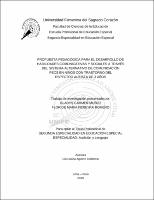| dc.contributor.advisor | Aguirre Ledesma, Lía Lesvia | |
| dc.contributor.author | Muñoz, Gladys Carmen | |
| dc.contributor.author | Pereyra Romero, Flor de María | |
| dc.date.accessioned | 2018-09-06T16:54:54Z | |
| dc.date.available | 2018-09-06T16:54:54Z | |
| dc.date.issued | 2018 | |
| dc.identifier.uri | http://hdl.handle.net/20.500.11955/454 | |
| dc.description.abstract | El presente trabajo, evidencia los beneficios del Sistema Alternativo de comunicación PECS en niños con TEA de 3 años. Se explica los fundamentos teóricos de diversos sistemas alternativos y aumentativos de comunicación. El PECS, es un método interactivo de comunicación para niños no verbales y permite el desarrollo de habilidades comunicativas funcionales, potenciando la comunicación dentro del entorno familiar, educativo y social. Consiste en el intercambio de imágenes entre un niño no hablante y su interlocutor. El símbolo es utilizado para solicitar un objeto o hacer una petición. Cuenta con 6 fases; fase 1 intercambio físico, fase 2 aumentar la espontaneidad, fase 3 discriminar la figura, fase 4 estructurar frases, fase 5 responder a ¿Qué deseas? y fase 6 respuestas y comentarios espontáneos. Al final del trabajo se presenta un programa, de nueve sesiones significativas, para trabajar con los padres de familia el entrenamiento en el uso del PECS. Estas sesiones son: Me comunico con mi hijo autista a través de imágenes, aprendiendo el uso del PECS 1ra. fase, uso del PECS en la 2da.fase para lograr la comunicación con el niño, elaborando el tablero de comunicación para mi hijo con autista, empleo el tablero de comunicación para informar lo que deseo, uso del PECS en la 3ra. fase discriminación de la figura que desea, uso del PECS en la 4ta. fase estructura de la frase, uso del PECS en la 5ta. fase el niño responde a ¿Qué deseas? y la última sesión respondo y hago comentarios espontáneos ante una pregunta. | es_PE |
| dc.description.abstract | This work, evidence the benefits of the alternative communication system PECS, in the first and second phase in children with Autistic Spectrum Disorder of 3 years. It explains the theoretical foundations of various alternative and augmentative communication systems. PECS, is an interactive method of communication for nonverbal children and allows the development of functional communicative skills, enhancing communication within the family, educational and social environment. It consists of the exchange of images between a non-speaking child and his interlocutor. The symbol is used to request an object or make a request. It has 6 phases; Phase 1 Physical exchange, Phase 2 Increase spontaneity, Phase 3 discriminate figure, Phase 4 sentence structure, Phase 5 respond to What do you want? Phase 6 spontaneous responses and comments. At the end of the work, a program is presented of nine significant sessions, to work with the parents the training in use of the PECS. These sessions are: 1st phase I communicate with my autistic child through images, learning to use the PECS Using the PECS. 2nd. Phase for communication with the child, preparing the communication board, for my autistic child, I use the communication board to inform what I want. 3rd Phase discrimination of the figure you want. 4th Phase sentence structure, using the PECS 5th Phase the child responds to What do you want? and the last session I respond and I make spontaneous comments before a question. | es_PE |
| dc.description.uri | Trabajo de investigación | |
| dc.format | application/pdf | es_PE |
| dc.language.iso | spa | es_PE |
| dc.publisher | Universidad Femenina del Sagrado Corazón | es_PE |
| dc.rights | info:eu-repo/semantics/closedAccess | es_PE |
| dc.rights.uri | https://creativecommons.org/licenses/by-nc-nd/4.0/ | es_PE |
| dc.source | Repositorio Institucional - UNIFÉ | es_PE |
| dc.subject | Comunicación interpersonal | es_PE |
| dc.subject | Habilidades sociales | es_PE |
| dc.subject | Programas de comunicación | es_PE |
| dc.subject | Niños autistas | es_PE |
| dc.subject | Educación especial--Trabajo de investigación | es_PE |
| dc.title | Propuesta pedagógica para el desarrollo de habilidades comunicativas y sociales a través del sistema alternativo de comunicación PECS en niños con trastorno del espectro autista de 3 años | es_PE |
| dc.type | info:eu-repo/semantics/bachelorThesis | es_PE |
| thesis.degree.name | Segunda Especialidad en Educación Especial. Especialidad: Audición y Lenguaje | es_PE |
| thesis.degree.grantor | Universidad Femenina del Sagrado Corazón. Facultad de Ciencias de la Educación | es_PE |
| thesis.degree.level | Título de Segunda Especialidad | es_PE |
| thesis.degree.discipline | Educación Especial. Especialidad: Audición y Lenguaje | es_PE |
| dc.subject.ocde | https://purl.org/pe-repo/ocde/ford#5.03.02 | es_PE |
| renati.advisor.dni | 09166965 | |
| renati.advisor.orcid | https://orcid.org/0000-0001-9967-3069 | es_PE |
| renati.author.dni | 09976335 | |
| renati.author.dni | 08661070 | |
| renati.discipline | 141149 | es_PE |
| renati.level | http://purl.org/pe-repo/renati/level#tituloSegundaEspecialidad | es_PE |
| renati.type | http://purl.org/pe-repo/renati/type#trabajoDeInvestigacion | es_PE |
| dc.publisher.country | PE | es_PE |


